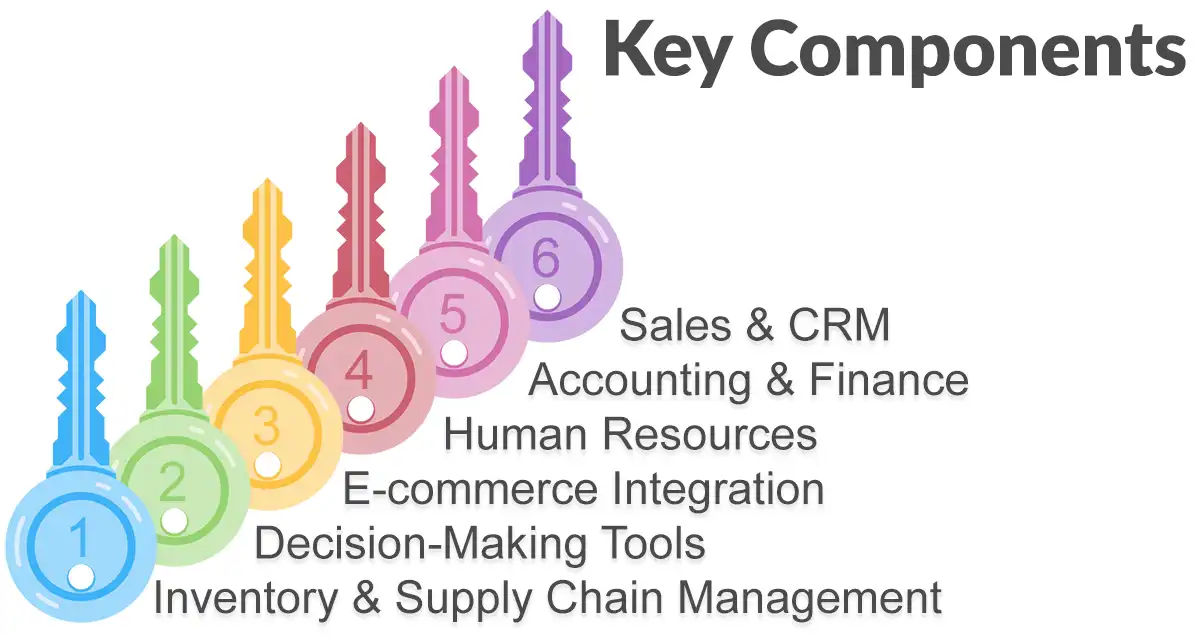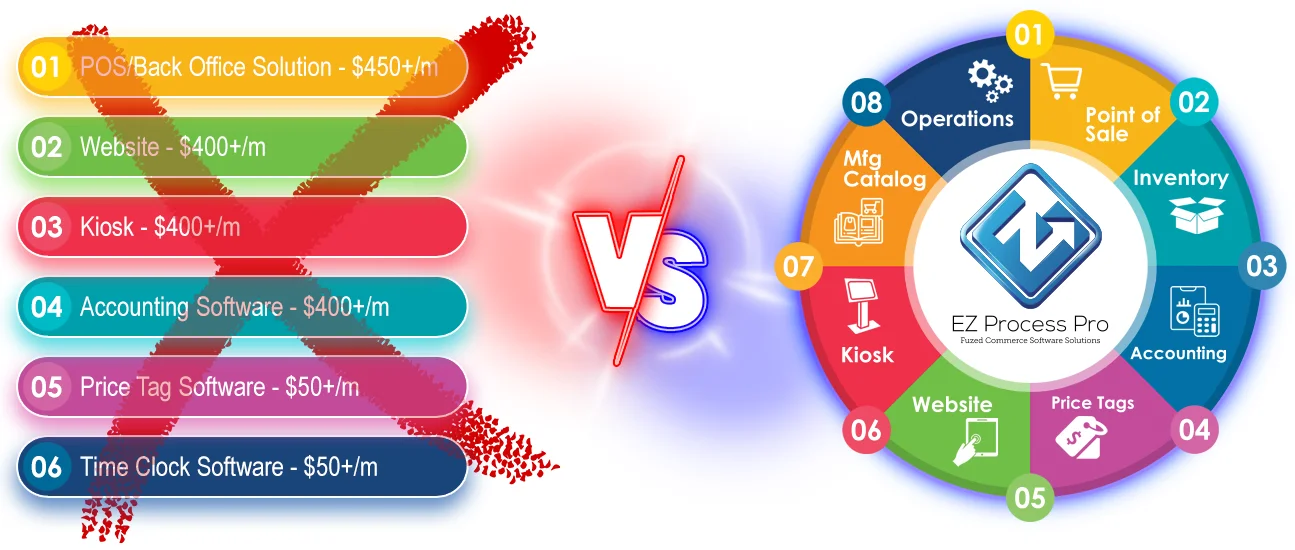What Is Cloud ERP? How It Works and Key Benefits
Many furniture business owners like you face common challenges, such as managing complex supply chains, tracking inventory levels, and ensuring timely deliveries. However, the future of the furniture business lies in the digital, and cloud-based ERP systems empower you to embrace this future by providing flexible, scalable, and secure platforms.
But how do you move your business to the cloud, and will it be complicated?

In this blog post, we explore cloud ERP, an innovative approach to enterprise resource planning that is revolutionizing business operations. We explain how cloud ERP works, its key benefits, and why it is particularly well-suited for the furniture industry.
Main Takeaways From This Article:
- Furniture businesses can improve operations and customer service by adopting cloud ERP, with solutions like EZ Process Pro offering tailored solutions.
- Key components such as Sales & CRM, Inventory Management, and Accounting work seamlessly in the cloud ERP environment.
- The benefits of cloud ERP range from cost-effectiveness to enhanced data security, providing significant value to businesses.
- Transitioning to cloud ERP requires careful planning, including assessing business needs, selecting the right solution, and ensuring proper training.
What Is Cloud ERP Software?
Cloud ERP, or cloud-based Enterprise Resource Planning, is software that integrates essential business functions such as sales, inventory, accounting, and human resources, all hosted on remote servers accessible through the Internet. Unlike traditional on-premises ERP systems that require expensive hardware and IT support, cloud ERP software supports businesses with a secure, user-friendly, and cost-effective alternative.
Traditional ERP vs. Cloud ERP
So, what makes cloud ERP different from traditional on-premise ERP systems?
Traditionally, ERP systems were installed on local servers within a company's IT infrastructure. This required substantial upfront investment in hardware, software licenses, and ongoing IT staff to maintain the system. Scalability was limited and made it difficult for businesses to expand their operations without making major infrastructure upgrades.

Cloud ERP disrupts this model by shifting the burden of hardware and maintenance to the cloud service provider. Businesses simply pay a subscription fee to access the software, eliminating the need for large upfront investments. It's also easy to scale your business using cloud ERP because resources automatically adjust to meet your changing business needs. Cloud ERP allows:
- Users to access the system from anywhere with an internet connection, promoting the remote work culture and better collaboration
- Cloud ERP providers to continuously update their software, ensuring you always have access to the latest features and security patches
- Companies to free up their IT team to focus on strategic initiatives as server management and software maintenance get outsourced
Given these clear advantages in terms of flexibility, cost-effectiveness, and ease of use, it's a small wonder that businesses are increasingly switching to cloud ERP.
Types of Cloud ERP
There are various deployment models for cloud ERP, offering flexibility to businesses based on their unique needs and security considerations:
- Public Cloud ERP: This utilizes a shared infrastructure hosted by a cloud service provider like Amazon Web Services (AWS) or Microsoft Azure. It offers the most cost-effective option but may limit customization.
- Private Cloud ERP: This model dedicates a virtualized server environment to your business, providing increased security and control but comes at a higher cost.
- Hybrid Cloud ERP: This combines public and private cloud environments, allowing businesses to control sensitive data in a private cloud while leveraging the scalability and cost-efficiency of the public cloud for other functions.
Cloud ERP solutions can also be categorized based on user tenancy:
- Single-Tenant Cloud ERP: This dedicates a complete ERP instance to a single business, offering maximum control and security. However, it's often more expensive than multi-tenant solutions.
- Multi-Tenant Cloud ERP: This model serves multiple businesses on a single infrastructure. It's more cost-effective but offers less customization compared to single-tenant solutions.
Key Components of Cloud Enterprise Resource Planning Software

Cloud ERP software typically encompasses a range of core modules that work together to streamline your business operations. Here are some particularly relevant modules for furniture businesses:
Sales & CRM
This powerful tool helps with customer relationship management and boosts sales performance. It does this by centralizing customer information, tracking sales opportunities, managing leads, and streamlining the sales process. This component is invaluable for any organization looking to improve their sales performance.
Inventory & Supply Chain Management
Centralized inventory management allows for real-time tracking of stock levels. It streamlines purchasing processes, optimizes inventory levels, and ensures timely replenishment. Integrating with supply chain partners improves visibility into the entire supply chain, reduces lead times, and improves customer satisfaction.
Accounting & Finance
This automates financial processes, such as invoicing, payments, and expense management, and provides real-time financial insights, simplifies tax compliance, and streamlines financial reporting. Automating routine tasks improves accuracy, reduces errors, and frees up resources for strategic financial analysis.
Human Resources
The HR component centralizes employee information, including payroll, benefits, and performance reviews. It simplifies HR processes, improves employee engagement, and streamlines talent acquisition and management. By automating HR tasks, it reduces administrative burden, improves efficiency, and enhances employee satisfaction.
E-commerce Integration
This component seamlessly integrates your online store with your ERP system, synchronizing product information, inventory levels, and order fulfillment. It ensures accurate order processing and efficient shipping. By integrating your online and offline channels, you can provide a consistent customer experience and improve sales.
Decision-Making Tools
These tools provide real-time analytics and reporting dashboards that offer valuable insights into your business performance. They help you identify trends and optimize operations. By leveraging data-driven insights, businesses can improve their decision-making and achieve better results.
Benefits of a Cloud ERP System
Cloud ERP systems offer a host of advantages that directly enhance your business operations. By leveraging the power of the cloud, you can unlock:
Flexibility & Accessibility
Cloud ERP offers unparalleled flexibility and accessibility. It lets you manage your business operations from anywhere, anytime, on any internet-connected device. This means your team can work efficiently, no matter where they are.
Scalability
These new-age systems offer unmatched scalability, allowing businesses to grow and adapt without the constraints of traditional ERP solutions.
As your company expands, you can adjust server capacity and storage, ensuring that your business is optimized for fluctuating demands. This eliminates the stress of hardware upgrades and helps avoid large capital investments, making growth manageable and economical.
Cost-Effectiveness
Cloud ERP solutions are a cost-effective alternative to traditional on-premise systems, offering several financial advantages. These include eliminating the need for expensive hardware, software licenses, and IT infrastructure, which can significantly reduce upfront and ongoing costs.
In addition, cloud-based models often offer flexible subscription plans, allowing you to pay only for the resources you need. These advantages make cloud ERP solutions a compelling option for many organizations.
Real-Time Data Access
With cloud ERP, you get a business management solution that provides real-time access to your business data. You can identify trends, respond to changes, and optimize your operations.
When you have instant access to critical business information, you can uncover valuable insights that drive better decision-making. This directly translates into improved outcomes that positively impact your bottom line.
Seamless Integration with Other Systems
Integrating cloud ERP systems with various business applications like CRM, accounting, and e-commerce platforms creates a seamless flow of information, breaking down data silos.
This, in turn, enhances operational efficiency and allows for a streamlined workflow, ensuring that all departments have access to synchronized and accurate data. Consequently, it improves decision-making and accelerates business processes by providing real-time insights across the organization.
Data Security and Reliability
Cloud providers invest heavily in robust security measures designed to safeguard your sensitive data. With robust security protocols and regular data backups, you can rest assured that your information is safe and reliable.
Moreover, cloud-based systems often benefit from the latest security patches and updates, minimizing the risk of cyber threats.
Key Reasons for Furniture Businesses to Consider Cloud ERP
Here are some key reasons why furniture businesses should consider adopting the cloud ERP system:
Centralized System for Multi-Location Management
Managing multiple store locations can be a complex task. A cloud ERP system provides a centralized platform to oversee all your operations, regardless of location. This allows you to consolidate data, standardize processes, and maintain consistency across all your stores.
Real-Time Inventory Accuracy
Keeping track of inventory is crucial for furniture businesses. A cloud ERP system helps you see your inventory levels in real-time, so you always know what products you have and where they are. This helps you avoid running out of stock, prevents lost sales, and improves your supply chain.
Seamless E-commerce and In-Store Integration
In today's omnichannel world, it's essential to have a seamless integration between your online and offline channels. A cloud ERP system can help you synchronize inventory levels, pricing, and promotions across all channels. This ensures consistency and eliminates the risk of stock discrepancies.
Remote Access for Better Oversight
With remote access capabilities, you can monitor your business operations from anywhere, anytime. This allows you to oversee inventory levels, sales performance, and employee activity, even when you're not physically present at your store locations. This level of oversight empowers you to make informed decisions and respond to challenges promptly.
Improved Customer Service
By providing real-time access to customer information, order history, and inventory levels, cloud ERP empowers your team to deliver exceptional customer service. With accurate and up-to-date information, you can quickly address customer inquiries, resolve issues, and provide personalized support. This leads to increased customer satisfaction and loyalty.
Steps to Take When Transitioning to Cloud ERP

Transitioning to a cloud ERP system can be a major undertaking. The following four steps will help ensure a smooth transition and optimize your new system's benefits.
1. Assess Your Business Needs
Before you implement a cloud ERP system, it's crucial to assess your business's specific needs and requirements.
Consider factors such as your industry, company size, and the functionalities your business requires and prioritize these in the chosen solution. By understanding your unique needs, you can select a cloud ERP solution that aligns with your goals.
2. Select the Right Cloud ERP Solution
Choosing the right cloud ERP solution is a critical decision. Research different cloud ERP vendors, evaluate their offerings, and consider factors such as functionality, scalability, security, and pricing. It's also important to assess the vendor's reputation, customer support, and implementation services.
3. Plan a Seamless Transition
Without a well-planned transition, disruptions to your business operations might occur. So, develop a detailed implementation plan, outlining key milestones, timelines, and resource allocation.
Conduct thorough data migration, ensuring accurate and complete transfer of information. Consider a phased approach to implementation, starting with core functionalities and gradually expanding to other modules.
4. Provide Training and Support
Proper training is crucial to maximize the benefits of your cloud ERP system. Provide comprehensive training to your employees, covering all aspects of the system, from basic navigation to advanced functionalities.
Plus, ensure that you have access to reliable support and maintenance services to address any issues or questions that may arise.
Potential Challenges of Cloud ERP
While cloud ERP offers several benefits, it's essential to be aware of potential challenges and how to mitigate them.
Data Migration Complexity
Migrating large volumes of data from legacy systems to a cloud ERP can be a complex and time-consuming process. Data quality issues, incompatibility, and security concerns can further complicate the migration.
How to overcome this challenge: Thoroughly plan the migration process, clean and validate data, and work closely with your cloud ERP vendor to ensure a smooth transition.
Internet Dependency
As a cloud-based solution, cloud ERP relies on a stable internet connection. Interruptions or slow internet speeds can impact system performance and user productivity.
How to overcome this challenge: Invest in a reliable internet connection, implement a robust backup and disaster recovery plan, and consider using a reliable VPN for remote access.
Customization Limitations
Cloud ERP systems, while highly customizable, may have certain limitations compared to on-premise solutions. Businesses with highly specific needs might find it challenging to tailor the system to their exact requirements.
How to overcome this challenge: Choose a vendor that offers flexible customization options and a strong track record of meeting diverse business needs. You can also combine a cloud ERP solution with custom-built applications to address specific requirements.
EZ Process Pro: A Cloud ERP Solution for the Furniture Industry
We understand the complexities of the furniture industry and are committed to your success.
Our software, EZ Process Pro is a fully cloud-based ERP system designed specifically for the furniture industry. It offers a comprehensive suite of features that cater to the unique challenges and requirements of furniture retailers:
- Centralized Management: Manage your entire business using a single platform, including inventory, sales, finance, and customer relationships, from anywhere with an internet connection. The platform integrates all these functions to offer round-the-clock accessibility to key data.
- Real-Time Inventory Tracking: Gain real-time insights into your stock levels across all locations, eliminate stockouts, optimize your purchasing decisions, and ensure smooth order fulfillment.
- E-commerce Integration: Easily connect your online store with our cloud ERP system and synchronize product information, inventory levels, and order processing for a unified customer experience across online and offline channels.

If you're ready to experience the transformative power of cloud-based ERP for your furniture business, book a discovery call with us. Our experts will discuss your specific needs and demonstrate how our solution can streamline your operations and accelerate your growth.
Schedule a Discovery Call EZ Process Pro
EZ Process Pro